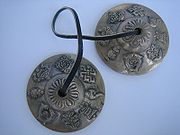
Tibetan tingsha bells
Encyclopedia


Cymbal
Cymbals are a common percussion instrument. Cymbals consist of thin, normally round plates of various alloys; see cymbal making for a discussion of their manufacture. The greater majority of cymbals are of indefinite pitch, although small disc-shaped cymbals based on ancient designs sound a...
s used in prayer and rituals by Tibetan Buddhist
Buddhism
Buddhism is a religion and philosophy encompassing a variety of traditions, beliefs and practices, largely based on teachings attributed to Siddhartha Gautama, commonly known as the Buddha . The Buddha lived and taught in the northeastern Indian subcontinent some time between the 6th and 4th...
practitioners. Two cymbals are joined together by a leather strap or chain. The cymbals are struck together producing a clear and high pitched tone. Typical sizes range from 2.5–4 inches in diameter. Tingsha are very thick and produce a unique long ringing tone. Antique tingsha were made from special bronze
Bronze
Bronze is a metal alloy consisting primarily of copper, usually with tin as the main additive. It is hard and brittle, and it was particularly significant in antiquity, so much so that the Bronze Age was named after the metal...
alloy
Alloy
An alloy is a mixture or metallic solid solution composed of two or more elements. Complete solid solution alloys give single solid phase microstructure, while partial solutions give two or more phases that may or may not be homogeneous in distribution, depending on thermal history...
s that produce harmonic overtones.
In high quality tingsha, both cymbals will match—the tones are identical or nearly identical. Most tingsha, however, are not perfectly matched so each produces a distinctly different tone. This is due to modern manufacturing processes in which many tingsha are produced at the same time and then poorly matched. Fine quality examples of antiques or the rare pair of carefully matched new tingsha will sound identical.
Antique tingsha are rare and quite expensive. Sometimes two cymbals that do not match are paired together. Single cymbals are often sold with a bone or piece of wood attached, so the instrument is still functional even though the mating cymbal has been lost.
Tingsha are unique in form and function and distinctly different from Indian, Nepali, Chinese, Turkish or other cymbals.
Today, tingsha are used along with singing bowls and other instruments in meditation, music and sound healing. Artists such as Karma Moffett and Joseph Feinstein use multiple pairs of antique tingsha together to create a sonic tapestry effect.
Traditionally, however, tingsha are used as part of specific Tibetan rituals, such as offerings to "hungry ghosts." While they are commonly found today in musical recordings and yoga classes, their real function is as a religious ritual tool.

